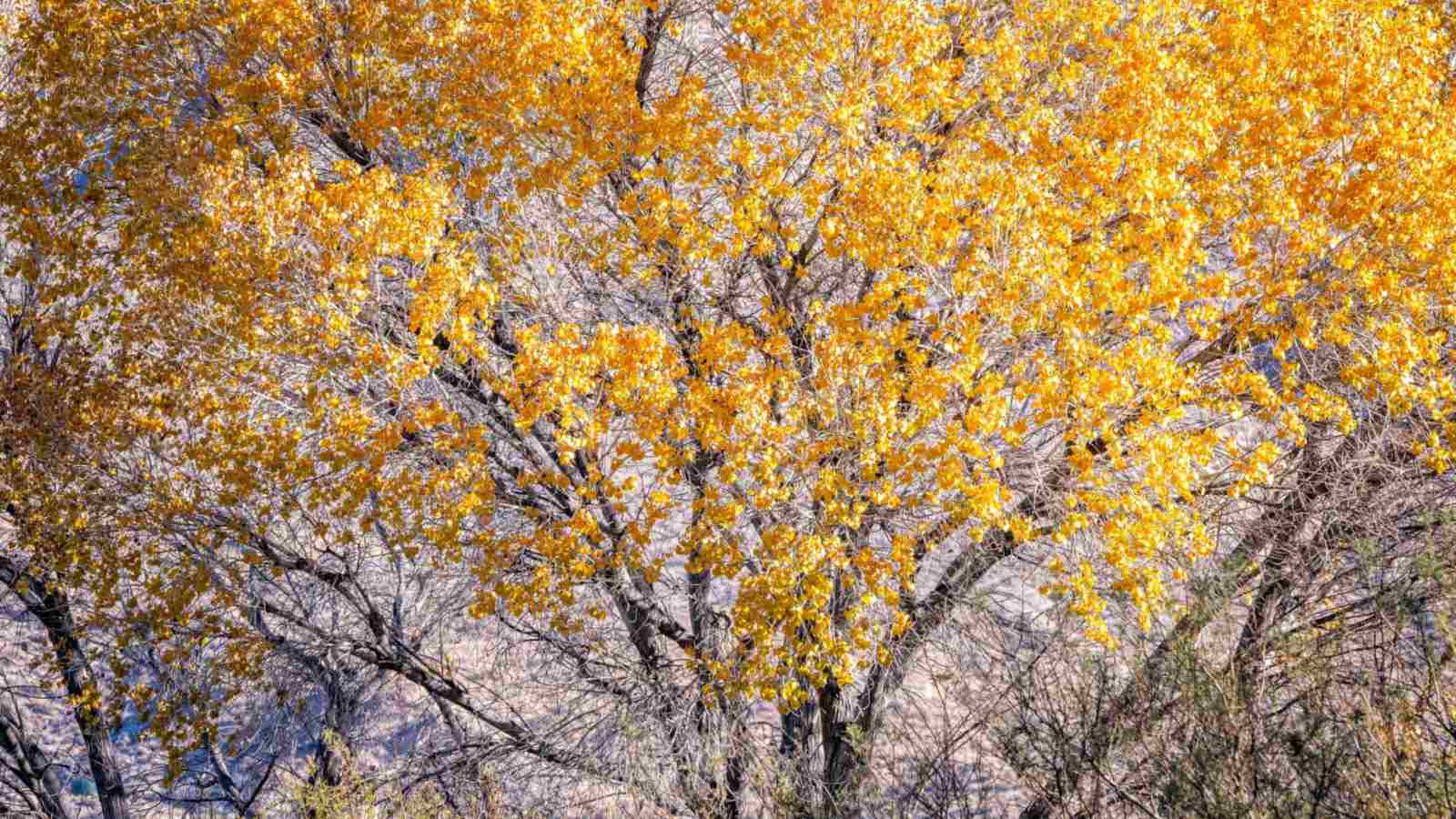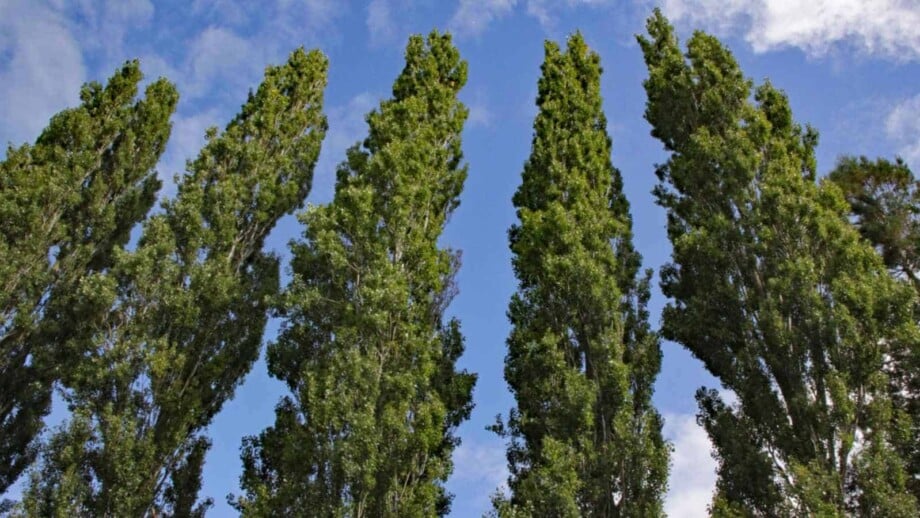Poplar trees, belonging to the genus Populus, are a diverse group of tree species that are native to North America, Europe, and Asia. They are known for their rapid growth rates and hardy nature, making them popular choices for landscaping purposes.
Poplars have a wide range of applications, from being used as shade trees to providing timber for building materials. The wood of poplar trees is lightweight and versatile, making it suitable for various purposes, including the production of plywood.
These trees are known for their rapid growth, which makes them an excellent choice for those seeking quick shade or a fast-growing windbreak. They prefer full sun exposure and thrive in a variety of soil conditions.

Poplars have strong root systems that help stabilize the tree and make them resistant to wind and storms. However, it is important to note that poplar trees can be invasive and their vigorous root systems may cause damage to underground structures such as pipes and sidewalks. Therefore, it is advisable to carefully consider their placement in the landscape.
Whether you’re planting them for their aesthetic appeal or their practical uses, these trees have a lot to offer. As a master gardener, I’ll walk you through the most popular types of poplar trees and share everything you need to know about them along with some pictures.
1. Japanese poplar (Populus maximowiczii)
Hardiness Zones: 4 – 8 (USDA)
Mature Size: Up to 100 feet in height, 40 feet in diameter
Light: Full sun
Soil Needs: Well-drained, loamy, or sandy

The Japanese Poplar, also known as Maximowicz’s poplar, is a native of Japan and a part of the genus Populus; the Salicaceae family, commonly known as the willow family. It naturally thrives in USDA Hardiness Zones 4 – 8, showing its robust hardiness zone adaptability.
What makes the Japanese poplar special is its rapid growth rates, which easily match those of hybrid poplars. The bark of the mature tree might not exhibit the white characteristic of white poplar (Populus alba), but it still adds an appealing visual element in ponds or riverbanks.
Any gardener should consider growing this poplar species for their landscape for several reasons. Firstly, it serves as a perfect shade tree due to its dense leaf canopy, creating respite from the full sun in those hot summer months.
Its requirement for well-drained soil also makes it a great addition to riverbanks or pond-side landscapes. Lastly, Japanese poplar can easily mingle among other trees like willows, aspens, or even the North American native, quaking aspen (Populus tremuloides), creating a diverse and dynamic ecosystem right in your backyard.
2. Big-Tooth Aspen (Populus grandidentata)
Hardiness Zones: 3 – 6 (USDA)
Mature Size: Up to 60 feet in height, 30-foot diameter
Light: Full sun
Soil Needs: Well-drained, sandy or loamy

The Big-Tooth Aspen, also known under the genus Populus grandidentata, is a hardy poplar species native to North America. This member of the Salicaceae, or willow family, thrives in USDA hardiness zones 3 – 6, marking its adaptability to different climatic conditions.
What makes the Big-Tooth Aspen special is its high growth rates and distinctive white bark that peels off revealing a greenish-gray hue. The underside of its leaves, heart-shaped with coarse margins, are silvery-white adding on to its visual appeal. Also, during fall, the tree enchants with vibrant yellow foliage.
The mature Big-Tooth aspen offers an astonishing landscape presence as a shade tree, making it a must-consider for enthusiastic gardeners. Whether you want a spectacular specimen tree or a wildlife attracter, this Aspen serves both purposes.
Its root systems are robust, ensuring it is a hard choice that can withstand varying conditions. Plus, this species offers the added benefit of serving as an excellent source of pulp, making it beneficial for plywood applications.
3. Quaking Aspen (Populus tremuloides)
Hardiness Zones: 1 – 6 (USDA)
Mature Size: Up to 50 feet in height, 20 feet in diameter
Light: Full sun
Soil Needs: Loose, well-draining

The Quaking Aspen, or Populus tremuloides, is a member of the genus Populus and part of the willow family, Salicaceae. It’s a native of North America, cherished for its striking white bark and trembling leaves – hence the common name “quaking”.
What makes this tree special is its unique feature of not just fluttering leaves, but the stark contrast of its white bark with green, heart-shaped leaves that flip to reveal silvery undersides in a breeze. This tree is hardy, adaptable and has one of the fastest growth rates among the poplar species.
Every gardener should consider growing the Quaking Aspen. While it serves wonderfully as a shade tree, it is noteworthy for transforming the landscape with its spectral beauty, particularly in the fall when its leaves turn a brilliant golden-yellow.
Besides, it is robust and treads well across many USDA zones. Finally, this poplar’s root systems are known for their extensive nature, providing soil stabilization and erosion control, an added benefit for any landscape.
4. Lombardy Poplar (Populus nigra)
Hardiness Zones: 2 – 10 (USDA)
Mature Size: Up to 80 feet in height, with a 10-foot diameter
Light: Full Sun
Soil Needs: Tolerant of a wide range, prefers well-drained soil

The Lombardy Poplar (Populus nigra), a member of the genus Populus and the Salicaceae or willow family, is a majestic shade tree prized for its glorious height and decorative appeal. This species of poplar, native to Europe, is famed for its growth rates, reaching maturity swiftly and creating an imposing presence in any landscape.
One of this poplar tree’s distinctive features is its white bark, which lends a striking contrast to the triangular leaves on its trunks. The leaves are interesting in themselves, characterized by undersides of white and petioles, causing them to quiver or “quake,” giving rise to their common name – the black poplars.
As a gardener, this should be on your list of considerations. The Lombardy poplar offers you more than just a sturdy shade tree.
It’s hardy and adaptable, tolerating different zones and conditions, while its root systems are excellent at preventing soil erosion. Moreover, its male catkins – long, slender flower clusters – boast an almost ethereal beauty.
Celebrate the intersection of utility and beauty with the Lombardy Poplar. It’s a testament to nature’s versatility and charm.
5. White Poplar (Populus alba)
Hardiness Zones: 2 – 9 (USDA)
Mature Size: 12-20 meters in height and up to 1 meter in diameter
Light: Full Sun
Soil Needs: Well-drained, can tolerate a variety of soil types

The White Poplar, scientifically known as Populus alba, is a species of poplar tree that is both beautiful and hardy. Known for its white bark and heart-shaped leaves, the underside of which is white, hence its common name.
This is a tree native to Europe and western and central Asia but has found its way to North America, cements its place in the genus Populus within the willow family, Salicaceae.
Two features set this poplar species apart: its growth rate and its unique leaf structure. Rapid growth rates and adaptability make the tree a popular choice among gardeners and landscapers. The triangular leaves, with a gray underside create a brilliant contrast amidst the landscape, quaking in the breeze much like its relative, the quaking aspen (Populus tremuloides).
Any gardener should consider growing the white poplar tree for its visual impact, shade, and interesting bark texture. Furthermore, the male trees bear long, drooping catkins before the leaves emerge, offering a lovely spring display.
But beyond aesthetics, the Populus alba, with its hardy nature and versatility, is truly a gift to the gardener and the garden.
6. Willow-leaved Poplar (Populus angustifolia)
Hardiness Zones: 3 – 9 (USDA)
Mature Size: Up to 50 feet high; crown spread up to 30 feet
Light: Full sun
Soil Needs: Moist, but well-drained and slightly alkaline to neutral soils

The Willow-leaved Poplar, also known by its scientific name, Populus angustifolia, is a member of the Salicaceae family, which also includes willows and aspens. This delightful tree, native to North America, takes on a majestic posture at maturity, with a beautiful crown of narrow, willow-like leaves that dance tirelessly in the wind.
What makes it special, is its elegant, tall shape, coupled with the unique sight of its leaves, which are deep green with silvery undersides. During the fall season, these leaves turn a captivating golden color, breathing life into the landscape with its vibrant hues.
Why should gardeners consider this tree? Well, its fast growth rates and hardiness make it a practical choice for many environments. Plus, it provides an amazing aesthetic appeal as a standalone specimen or when planted in groups.
Its high resistance to pests and diseases further adds to its gardening merits. With the right care and conditions, the Willow-leaved Poplar would surely make a stellar addition to any garden.
7. Gray Poplar (Populus x canescens)
Hardiness Zones: 5 – 8 (USDA)
Mature Size: 40 – 50 feet
Light: Full sun
Soil Needs: Well-drained

Gray Poplar (Populus x canescens), a stalwart of the Populus genus, is a remarkable blend of beauty and durability. It’s a robust hybrid of white poplar (Populus alba) and Populus tremulus.
What sets the Gray Poplar apart is its hybrid vigor, flaunting accelerated growth rates that impress even seasoned horticulturists. Its leaves, akin to the quaking aspen, exhibit a flashy contrast with rich green topsides and whitish undersides shimmering beautifully in the wind.
Any gardener looking to inject life into their landscape should consider the Gray Poplar. Its heart-shaped leaves and mature trunks with white bark add a stately character to your garden, establishing it as an effective shade tree.
Plus, the tree’s hardy nature and wide hardiness zone adaptability make it a low-maintenance gem that vice versa enhances soil quality by stabilizing its root systems.
8. Eastern Cottonwood (Populus deltoides)
Hardiness Zones: 2 – 9 (USDA)
Mature Size: Up to 100 feet tall, 4.5-6 feet in diameter
Light: Full sun
Soil Needs: Moist and well-drained soil

The Eastern Cottonwood, scientifically known as Populus deltoides, is a native North American species belonging to the Salicaceae or Willow family.
Found throughout the United States, this poplar species is named after the fluffy cotton-like seeds it produces during its maturity. With a robust growth rate, it can reach impressive heights, comparable to other poplar species, like the Lombardy poplar tree and the balsam poplars.
Among its intriguing characteristics is the Eastern Cottonwood’s heart-shaped, broad triangular leaves. Each individual leaf is attached to a flexible stem or petiole, enabling the leaves to quiver in the breeze, mirroring characteristics of another North American species, the Quaking Aspen (Populus tremuloides).
The Eastern Cottonwood is hardy enough to endure various climatic zones. Reasonably resistant to pests, it can be an excellent choice for a shade tree. Its gray poplar-like bark gives it a captivating appearance in the landscape.
All these attributes combined with its numerous beneficial uses, ranging from landscaping to plywood, make this tree a must-consider addition to any gardener’s list.
9. Canadian Poplar (Populus x canadensis)
Hardiness Zones: 4 – 9 (USDA)
Mature Size: Up to 70 feet
Light: Full sun
Soil Needs: Prefers rich, loamy soil but adaptable to different soil types

Introduced to North America from Europe, the Canadian Poplar, also known as Populus x canadensis in the Salicaceae or willow family, is a fast-growing member of the genus Populus.
Characterized by its robust and hardy nature, this hybrid poplar instantly enhances any landscape with its majestic stature, vibrant green leaves and thick, grained bark. The undersides of the heart-shaped leaves flash silver in the wind, creating a beautiful shimmering effect.
A stand-out in the poplar species, it shares a strong similarity with the black poplars (Populus nigra) and white poplar (Populus alba), known for their rapid growth rates and large diameters. It’s also comparable to the balsam poplars, beloved for their aromatic, resinous buds invoking the scent of balm of Gilead.
When cultivated with care, these poplars produce catkins – long, pendulous clusters of flowers. Male and female flowers bloom on different trees, with the female flowers maturing into a papery capsule housing tiny seeds.
Reasons why gardeners should consider this species are many. Aside from being an impressive shade tree, it functions as a windbreak, controls erosion, and is effective for bio-remediation. A true delight for any horticulturist, the Canadian Poplar brings a native touch, rapid growth and undeniable charm to one’s garden.
10. Fremont Cottonwood (Populus fremontii)
Hardiness Zones: 3 – 9 (USDA)
Mature Size: Up to 115 feet
Light: Full Sun
Soil Needs: Well-drained

Fremont Cottonwood, or Populus fremontii, a native North American tree, belongs to the willow family, Salicaceae. This tree is a fascinating member of the Populus genus, commonly recognized for its fast growth rates and robust, hardy nature. It has gray-green leaves, triangular-form with rounded tips and margins, and a rough bark that tears off in longitudinal strips.
What makes the tree special is its adaptability to a wide range of zones and planting conditions. Preferred for landscapes due to its generous shade provision, the Fremont Cottonwood exhibits a splendid display of male and female flowers, often called catkins. The cotton-like substance that surrounds its seed capsule disperses widely, giving an enchanting falling cotton effect, a delight to behold in any garden.
Any master gardener should consider growing this tree for its majestic stature, hardiness, and the pleasing aesthetic touch it offers. Be it for contributing to native landscapes or using it as a fast-growing shade tree, the Fremont Cottonwood provides an exceptional gardening experience. Besides, its root system helps control erosion, adding an ecological touch to your garden. Mature trees develop an extensive system of roots and trunks that endure and thrive for decades, exemplifying endurance and maturity.
Other Tree Guides from Planet Natural:











